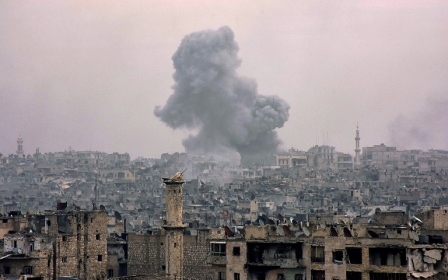Syria: What will happen if the revolution is defeated

Should the loss of Aleppo result in the end of the Syrian revolution, the outcome would be catastrophic for the country and the region as a whole.
Aleppo, which has been under siege for months, is just one battleground. Its occupation by the regime should not change the course of the war. The regime is weak. It has lost control and sovereignty and defeating it is still possible. It has tottered on the brink of defeat on more than one occasion in the past six years.
The Syrian revolution, just like other Arab revolutions, began as a peaceful and popular uprising. No one within its ranks wanted to resort to arms. Syrians were forced to defend themselves and their loved ones by the failure of the world to deter the regime and stop its bloody persecution.
The Syrian revolution turned into an armed confrontation only after many months of mass rallies in March 2011 and only after army officers and soldiers began dissenting and forming the first Free Army cells for the sake of protecting the popular movement.
The revolution was not a civil war, and this is not what the Syrian people wanted it to be. It was never meant to be one segment of the people mobilising against the other.
The revolution was, and it continued to be so for years, an expression of a big and wide popular movement aimed at building a new Syria, at regaining the freedom of the entire Syrian people and at establishing a democratic and just system.
However, the revolution did become an armed national liberation movement and a civil war, and the regime bears the primary responsibility for this. It vowed from the start to crush this popular movement with armed force and refused to meet the people half way.
'We taught them a lesson at Hama that silenced them for 40 years and I shall teach them a lesson that will silence them for 100 years'
- Bashar al-Assad
A meeting was held toward the end of March 2011 in the office of President Bashar al-Assad in Damascus. In that meeting, which was attended by a senior Hezbollah official in addition to Qasem Suleimani, the commander of the Iranian Revolutionary Guards Quds Force, the Iraqi minister of national security and the president's brother, Maher al-Assad, Assad said: "We taught them a lesson at Hama that silenced them for 40 years, and I shall teach them a lesson that will silence them for 100 years."
It was crystal clear to whom the president was referring. Nor where these just words. The regime's stances and policies were inherently sectarian. It sought to divide the Syrians into rebellious Sunnis and loyal Alawites.
As soon as the regime realised its inability to suppress the people and inflict defeat on them, it invited the sectarian militias from Lebanon, Pakistan and Afghanistan and invited the huge military support from Iran. And when all of these failed, it had no hesitation in inviting the Russians too.
A country of hell
Should the revolution be defeated and the status quo be accepted, the rule of the Assad regime will continue and the country will remain occupied by the foreign powers and militias.
The Syrian majority will have to suffer under a regime that will be much more vicious and oppressive than it was before the revolution in the spring of 2011. The regime that perpetrated all these massacres will not commit to any genuine reforms.
Syria will witness an unprecedented sectarian demographic re-engineering process, something it has never before experienced
In other words, if the revolution stops, Syria will turn into a country of hell for the majority of Syrians, a hell that will be more oppressive and much uglier than anything Syrians have witnessed over the past six years.
The refugees will not return to their homes, and Syria will witness an unprecedented sectarian demographic re-engineering process, something it has never before experienced. Even before the revolution comes to an end, some circles within Hezbollah and inside Iran are already talking about the Shia identity of Aleppo and about displacing the Sunni population from the west of Damascus to the Lebanese borders.
If the revolution stops, the Middle East will witness a major imbalance of power that will threaten the region with long-term instability.
Some efforts are being exerted in order to launch national negotiations within Iraq with the aim of restoring a national balance inside the country when the battle of Mosul is over.
If Iran is allowed to win in Syria, such efforts will be aborted and Iran will claim to have accomplished strategic control over the whole region extending from Basra in the south of Iraq all the way to the Syrian coast.
Such hegemony will not be in Iran’s own interest, because it will only ignite more wars in the region and will inflict severe harm on its own people and on the Shia Muslim populations as a whole in the Middle East. Nor will it be in the interest of the other countries in the region, which will witness internal sectarian eruptions and even civil wars.Iran's policy in the region has not shown any degree of rationality over the past two decades, and the illusion of having won the bloody war in Syria will not make it any more rational.
Instability will not be confined to Arab countries but will also touch Turkey, which will find itself faced with a sectarian wall that will isolate it from its Arab neighbourhood in the south and with a Russian aerial siege that begins from the air bases in the south of Russia, the north of Georgia and the Crimean Peninsula all the way to the Russian control of the Syrian airspace.
No time to surrender
Continuing the revolution is not therefore a futile act, nor is it fighting on for the sake of fighting. With some patience and steadfastness, this revolution can still win. In fact, it has been standing on the verge of winning.
Either return to the life of enslavement and fascist minority rule or continue the revolution until victory is achieved
This regime exists in no more than one third of the country, and in that third it shares control on the ground with Shia militias that poured in from several countries in addition to Iranian and Russian units. Even with all the support it receives from its allies, the regime is incapable of fighting two major battles at the same time.
Tadmur (Palmyra) illustrates the actual military power of the regime. It is not true that the Afghan militias alone undertook to protect the existence of the regime in Tadmur because the city had within it Syrian regular troops and Russian units as well.
According to Russian reports, as soon as the Islamic State group (IS) began its onslaught on Tadmur, the commander of the region's forces and most of his troops fled. As a result, the Russians needed to launch an air strikes campaign that lasted for several hours just to secure the withdrawal of their own troops.
Syria is the new Vietnam
Syria today is what Vietnam looked like in the early 1970s or Afghanistan in the mid-1980s. In both Vietnam and Afghanistan, the old regime seized control of the country's capital and ran a quasi-state and what may resemble state institutions. It spoke in the name of a small minority of the people, and its existence was secured and protected by the presence of a massive foreign power.
In both cases, there was no need for inflicting a decisive military defeat on the foreign forces; it was sufficient to exhaust them and make their presence unbearable, either as a result of the losses sustained continuously or as a result of the reaction of public opinion in their own countries.
Unlike the situation in Syria, where revolutionary forces control vast stretches of land across the country, the resistance forces in those two cases were not able to secure their presence in tangible areas in South Vietnam and in Afghanistan until quite late in the war.
- Basheer Nafi is a senior research fellow at the Al Jazeera Centre for Studies.
The views expressed in this article belong to the author and do not necessarily reflect the editorial policy of Middle East Eye.
Photo: Syrians evacuated from Aleppo arrive in the Khan al-Assal region west of the city, 18 December, 2016 (AFP).
This article is available in French on Middle East Eye French edition.
Middle East Eye propose une couverture et une analyse indépendantes et incomparables du Moyen-Orient, de l’Afrique du Nord et d’autres régions du monde. Pour en savoir plus sur la reprise de ce contenu et les frais qui s’appliquent, veuillez remplir ce formulaire [en anglais]. Pour en savoir plus sur MEE, cliquez ici [en anglais].






